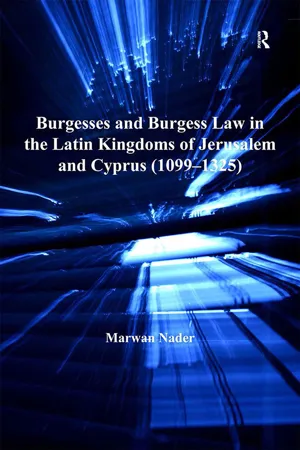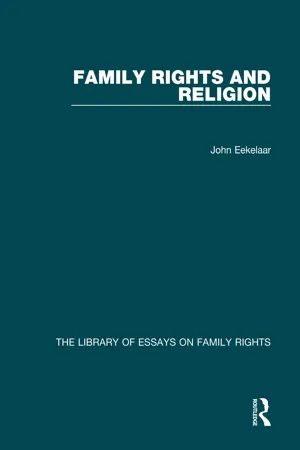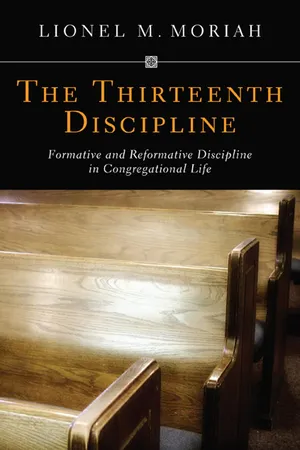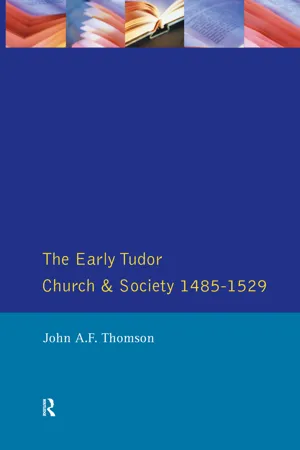History
Secular and Church Courts
Secular and church courts were two distinct legal systems in medieval Europe. Secular courts were responsible for handling civil and criminal cases, while church courts dealt with matters concerning religious law and morality. The relationship between these two court systems often led to conflicts over jurisdiction and authority, with the church asserting its independence from secular control.
Written by Perlego with AI-assistance
Related key terms
Related key terms
1 of 4
Related key terms
1 of 3
4 Key excerpts on "Secular and Church Courts"
- Marwan Nader(Author)
- 2016(Publication Date)
- Routledge(Publisher)
Chapter 5Church Courts
In this chapter, I propose to look beyond purely secular Frankish legislation and jurisdiction. There is reason to believe that ecclesiastical institutions played a vital role in defining the status of burgenses and in shaping the terms of borgesie tenure. In the history of the kingdom the Church’s influence was constant. In the eleventh century it had preached to non-feudatories the ideals of armed pilgrimage and remission of the sins of participants. On the First Crusade, at a time when Christian suffering could be interpreted as God’s punishment for men’s immorality, Church leaders helped establish a court to judge acts of impiety. And in the first decades of Frankish settlement, at assemblies such as the one held at Nablus in 1120, churchmen dispensed canons regarding various matters including marriage and miscegenation, for general application in the secular and ecclesiastical courts of the kingdom. In these early years the Church was instrumental in defining the rules under which Europeans were to live and work alongside indigenous Syrians, laying down the principle that Latin Christians were superior to all other religious communities. In its efforts to reinforce the ideals of a middle class composed of Latin Christians with legal privileges and property rights, the Church hoped to encourage the conversion of non-Latin natives to the Catholic faith. From the early existence of the kingdom, moreover, ecclesiastical institutions became wealthy and powerful landowners. Churchmen, such as the bishop of Lydda, were seigneurs justiciers who issued laws over burgesses living in their domains and had their own Cours des Bourgeois . There is reason to believe even, that in the context of burgess jurisdiction, the authority of churchmen extended beyond secular burgess courts. The intention of the following discussion is to demonstrate how the competence of Church courts over burgesses and borgesies in the cities and the Latin rural settlements went beyond the parameters of purely ecclesiastical jurisdiction. These judicial bodies helped uphold burgess written laws and unwritten customs. Richard and others who proposed the theory that in every city and village in the kingdom where there existed a Frankish population there was established a Cour des Bourgeois ,1- eBook - ePub
- John Eekelaar(Author)
- 2020(Publication Date)
- Routledge(Publisher)
Part V The secular state and religious groups 15 Civil and Religious Law in England: A Religious Perspective R OWAN W ILLIAMS Archbishop of Canterbury This is the complete text of the lecture delivered by the Archbishop of Canterbury at the Royal Courts of Justice on 7 February 2008, under the chairmanship of Lord Phillips of Worth Matravers, the Lord Chief Justice, as the Foundation Lecture in a series of public discussions on ‘Islam in English Law’. 1 The lecture seeks to tease out some of the broader issues around the rights of religious groups within a secular state, using sharia as an example and noting the substantial difference between ‘primitivist’ accounts of sharia and those of serious jurists within Islam. The Archbishop discusses the implications of some interpretations of Western secular legal systems, which seek to remove from consideration the actual religious motivations and practices of groups in plural societies. Where the law does not take religious motivation seriously, then it fails to engage with the community in question and opens up real issues of power by the majority over the minority and thus of community cohesion. It examines whether there should be a higher level of attention to religious identity and communal rights in the practice of the law: how to manage the distinction between cultural practices and those arising from genuine religious belief; and what to do about the possibility that a supplementary jurisdiction could have the effect of reinforcing in minority communities some of the most repressive or retrograde elements in them, with particularly serious consequences for the role and liberties of women - eBook - ePub
The Thirteenth Discipline
Formative and Reformative Discipline in Congregational Life
- Moriah(Author)
- 2011(Publication Date)
- Wipf and Stock(Publisher)
People do, as a matter of fact, bring legal actions against churches for, among other things, the imposition of church discipline, and churches should certainly be careful about which, and how, such measures are imposed. In reality, however, secular courts are not in a hurry to interfere in the affairs of churches—especially not doctrinal matters—and the concerns of churches about legal ramifications of the imposition of discipline are often overblown, more the result of misinformation about the actual facts of legal actions brought against churches, and a lack of knowledge about the law and its implications for the actions of churches, and about how many of the risks of legal action might—relatively easily—be minimized.Following the RulesThe first and most basic statement that must be made is that, in disciplinary matters as in others, the secular law sets out certain basic rules to which churches are subject, as they are to their own rules (e.g., as set out in the Church Covenant or Constitution and Bylaws or Operational Guidelines or Church Discipline Manual, etc.). A church cannot simply make up its disciplinary procedures as it goes along, nor ignore its own rules. Far too often, it is one of these two things—i.e., making the process up ad hoc , or ignoring its own rules and procedures and policies—that lands churches (as it does other organizations) in court.Christian Discipline and the Duty of FairnessChurches, like other voluntary associations, are generally free to structure their internal operations as their members choose. Generally—but not completely. Churches, like all other organizations, are required by the secular law to act with basic fairness—surely the minimum that the biblical standard demands of them as well. In Canada, complying with the basic legal duty of fairness is commonly referred to as acting in accordance with natural, or fundamental, justice. In the United States, it is usually referred to as acting in accordance with due process. - eBook - ePub
- John A.F. Thomson(Author)
- 2014(Publication Date)
- Routledge(Publisher)
24 Perhaps this attitude was exceptional, for there were undoubtedly areas of professional rivalry, and lawyers were among the fiercest critics of the Church's legal privileges, but it may well reflect the generally pragmatic approach taken to the question by the public as a whole.Theoretically the Church claimed two kinds of jurisdiction, in personam, matters concerning the discipline of clerks, and in rem, where matters were deemed of spiritual importance irrespective of whether the parties were clerical or lay. Cases before the courts, however, show that matters which might have been expected to fall within the competence of one jurisdictional system were actually heard in the other. Furthermore, churchmen were involved in proceedings before the royal courts and the lay authorities made pronouncements on some ecclesiastical matters. A notable example of this is a statute of Henry VII's first parliament, which declared that incontinent clerks should be punished by their ordinaries, at the bishop's discretion according to the extent of their vice.25 At first sight this might suggest lay intervention in a matter pertaining to the church courts, and as there is no obvious sign of episcopal negligence in correcting such offences, the purpose of the act seems unclear. Its final proviso, however, is that in such cases bishops and archbishops were to be discharged from any action for false imprisonment, leaving the implication that the statute was intended to strengthen the hands of the ecclesiastical authorities against offenders who were trying to play off church and lay courts against each other. It is even possible that the church authorities sought the act. A copy of it is transcribed in the Lincoln register of Bishop Russell, with a picture of a hand in the margin to draw attention to the entry; this demonstrates the importance attached to the act in that diocese, and leaves the possibility (albeit an unproven one) that a case from Lincoln may have prompted the passing of the measure.26
Index pages curate the most relevant extracts from our library of academic textbooks. They’ve been created using an in-house natural language model (NLM), each adding context and meaning to key research topics.
Explore more topic indexes
Explore more topic indexes
1 of 6
Explore more topic indexes
1 of 4



